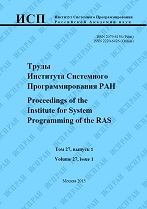|
Using modularization in embedded OS
K. A. Mallachievab, N. V. Pakulinbac, A. V. Khoroshilovdacb, D. V. Buzdalovb
a Lomonosov Moscow State University
b Institute for System Programming of the RAS
c Moscow Institute of Physics and Technology (State University)
d National Research University Higher School of Economics (HSE)
Abstract:
Modern embedded OS are designed to be used in control solutions in various hardware contexts. Control computers may differ in the architecture of the CPU, the structure of communication channels, supported communication protocols, etc. Embedded OS are often statically configured to create an OS image, which intended to be executed on some specific control computer. System integrator usually performs this configuration. Embedded OS are often developed by many companies. Joint development and integration is very complex if OS doesn’t support modularity. Support of modularity and component assembly reduces the need of communication among companies during development and integration. This allows customers to create minimal solutions that are optimally adapted to the particular task and hardware platform. Furthermore, customers may be interested in adding their own low level components without OS modification. In this article, we present an approach to building modular embedded solutions from heterogeneous components based on the RTOS JetOS. The mechanism of components binding developed by us allows uniting heterogeneous components from different manufacturers within the same section of the address space. This mechanism allows component developer to independently develop their components. And system integrator can independently from developers configure what component he likes to see in OS image and how components should interact.
Keywords:
embedded systems, components, RTOS.
Citation:
K. A. Mallachiev, N. V. Pakulin, A. V. Khoroshilov, D. V. Buzdalov, “Using modularization in embedded OS”, Proceedings of ISP RAS, 29:4 (2017), 283–294
Linking options:
https://www.mathnet.ru/eng/tisp250 https://www.mathnet.ru/eng/tisp/v29/i4/p283
|

| Statistics & downloads: |
| Abstract page: | 134 | | Full-text PDF : | 54 | | References: | 37 |
|




 Contact us:
Contact us: Terms of Use
Terms of Use
 Registration to the website
Registration to the website Logotypes
Logotypes








 Citation in format
Citation in format 